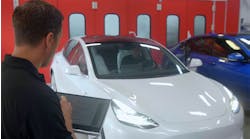Diamond Standard Parts formed a strategic partnership with the Automotive Service Association (ASA) in January. Under the agreement, Diamond Standard agreed to $40 million in product liability coverage for ASA-member shops.
That means member shops as a whole have up to $40 million worth of liability coverage when the use of a Diamond Standard part directly results in additional vehicle damage or injury to vehicle passengers in a future crash. Parts covered under the program, called Diamond Standard Security Shield, include all Diamond Standard brand parts manufactured by Reflexxion Automotive or Production Bumper Stampings.
The goal is to help shop operators avoid risk due to the use of structural parts from foreign manufacturers, says Geoff Crane, director of industry relations for Diamond Standard. He says there’s been an increase in aftermarket parts produced by Pacific Rim manufacturers—with various levels of quality and substitution—that don’t have any U.S. assets or liability coverage.
ASA shops are no longer the only repairers able to be protected under the program. Crane says the Diamond Standard Security Shield was opened to the industry at large this spring. The company is focusing the rollout of the program on the highest quality shops that are validated as having best practices and standards in place for parts usage and repair quality.
Crane says Diamond Standard is initially reaching out to collision industry consolidators, associations and networks of shops.
“Those organizations are affiliated with independent repair organizations that have high quality standards. Their shop affiliations have best practices in place in how to run a shop, generate maximum productivity, and training,” Crane says. “And partnering with those organizations would yield connections to several thousand shops.”
Crane says Diamond Standard is open to partnering directly with independent shops in the future. But that is a major administrative undertaking, and the company has not yet identified an efficient structure to manage independent shops separately.
“Given the serious nature of anyone installing a substandard or inferior structural part based on price selection—which has been shown to lead to increased damageability—Diamond Standard supports all collision centers that adopt best practices in selecting structural parts to accomplish a complete and safe repair,” Crane says.
But not everyone is convinced that such a program will benefit the collision repair industry. Dan Ducharme, genuine parts product manager for Volkswagen Group of America Inc., says U.S. parts manufacturers are always held liable for any product they produce—regardless of whether they extend formalized protection like Diamond Standard has.
“If damages are greater than the amount of liability protection being offered, the company would still be held liable anyway,” Ducharme says. “So what does this protection initiative really do? Rather than tackling the issue of crash testing, [Diamond Standard] is just trying to put everyone’s minds at rest by offering additional insurance coverage, which businesses should do anyway.”
“Diamond Standard is just trying to bring more credibility to the quality of their parts,” Ducharme adds. “I don’t know if this brings more credibility to their parts. I think they’re dancing around the real issue of proving that their parts fit, have been crash tested, and that they will maintain the integrity of a vehicle.”
Denise Caspersen, collision division manager for the ASA, recognizes that Diamond Standard’s initiative could be perceived as a marketing tactic. But if your shop uses aftermarket parts, she says the program offers valuable benefits nonetheless—both to your business and customers.
Caspersen says consumers always have a greater level of confidence in products that come with warranties. Explaining this type of protection to customers gives them more confidence in your repairs and business.
It also fosters an educational element for customers, Caspersen says. It gives you a reason to have in-depth part type discussions with customers beyond OEM versus aftermarket issues. Customers are able to play a stronger role in deciding what they want.
“Knowledge is power,” Caspersen says. “It raises the level of professionalism of your shop and the entire industry when you can educate customers about the choices they’re making for their vehicle.”
Caspersen says Diamond Standard is the first aftermarket manufacturer to launch such a program, but ASA has already had discussions with other manufacturers about that possibility.



